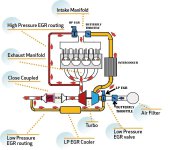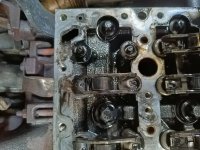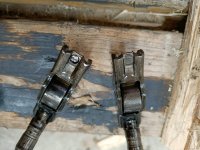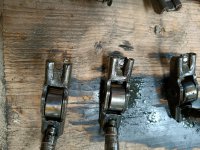Just purchased an auction sale ducato with engine problem description. black smoke / knocking sound. 180000 km manufactured 2016. Motor code F1AGL411D. Sounds great on idle. When revving up engine carefully it does not make any sound and less black smoke. When revving it up quickly there are wall painting amounts of black smoke and a knocking sound.
Clues
First thing i did was to clear a few codes to see if they pop up again, they havent. (P2244,p0238,p0236, p242e, p0547, p1248).
Changed fuel filter and there was some misshap with fuel assembly so I could se alot of dirt in the old filter.
Started it up after the fuel filter change and same engine behaviour. lots of smoke when revving and knocking sounds when revving quickly.
I can move the EGR valve manually (the one closes to the hood lock). The pipe leading up to it is wet/very moist inside)
I believe the coolant have a few drips of oil in it. but when I checked the oil heat exchanger the coolant looked fine down there, so only some oil in the coolant bottle (i'm thinking someone filled oil in the wrong place? and absolutely not the other thing you think about with oil in there
and absolutely not the other thing you think about with oil in there  )
)
I believe some oil seems to be leaking near the oil filler cap.
Help!
What should I inspect next? perhaps dismantle the egr manifold? turbo? Should any sensor malfunctioning around there give me new error codes if broken?
Clues
First thing i did was to clear a few codes to see if they pop up again, they havent. (P2244,p0238,p0236, p242e, p0547, p1248).
Changed fuel filter and there was some misshap with fuel assembly so I could se alot of dirt in the old filter.
Started it up after the fuel filter change and same engine behaviour. lots of smoke when revving and knocking sounds when revving quickly.
I can move the EGR valve manually (the one closes to the hood lock). The pipe leading up to it is wet/very moist inside)
I believe the coolant have a few drips of oil in it. but when I checked the oil heat exchanger the coolant looked fine down there, so only some oil in the coolant bottle (i'm thinking someone filled oil in the wrong place?
I believe some oil seems to be leaking near the oil filler cap.
Help!
What should I inspect next? perhaps dismantle the egr manifold? turbo? Should any sensor malfunctioning around there give me new error codes if broken?





